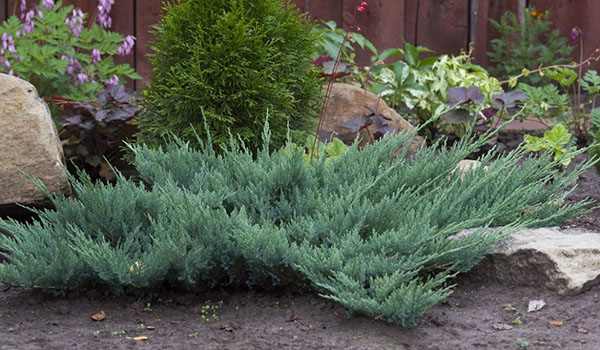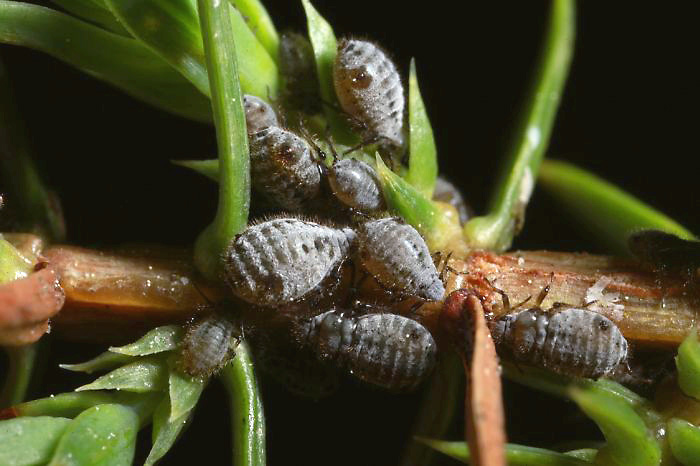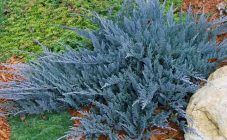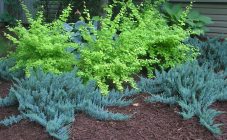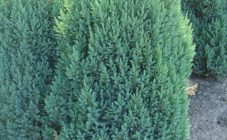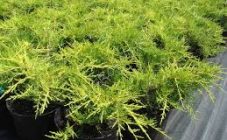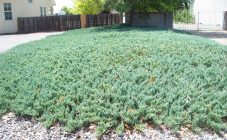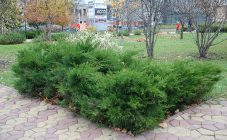Content:
Juniper is valued by gardeners for its ability to create a year-round green spot on the site, a beautiful combination with other plantings, and filling the surrounding air with phytoncides. Knowledge of the rules for planting and caring for this plant will help the gardener grow a spectacular green space in his summer cottage. This article contains all the nuances of growing a juniper.
Place and time of boarding
The landing site should be sunny and light. When growing in full shade, the plant will deform the crown. It will become loose, sloppy.
Juniper is planted in spring (April, May) and autumn (September, October). Provided that the plant was purchased grown in a container, it can be planted in summer. When planting in summer, the tree is shaded all season from direct sunlight and is often watered.
The clod of earth on the root system must remain intact. Scattering of soil will lead to root injury, which in turn can contribute to disease and death of the plant. Before planting, the container with the seedling is dipped in water to soak the coma. It is best to plant junipers when the weather is cloudy.
Soil and pit for planting
The width of the planting hole should be at least 2 times larger than the earthen lump of the juniper. It is dug up to a depth of 50-70 cm. Since the root system of the plant is sensitive to waterlogging, drainage is laid at the bottom of the pit: expanded clay, broken brick, small stones. A little sand is poured on top.
Although juniper is undemanding to the composition of the soil, it is still better to take a fertile one. You can prepare the substrate yourself: mix turf, peat and river sand in a 2: 1: 1 ratio.
Before planting a juniper in open ground, you need to prepare a hole. It is prepared in advance about 2 weeks before the ephedra planting. It is dug up, filled with drainage, then with a nutrient mixture. 100-200 g of nitroammofoska are added there, mixed with the soil mixture. After 2 weeks, the soil will settle, you can start planting.
Juniper: planting and care
Having chosen a suitable place, having previously prepared the planting pit, you can proceed directly to planting the juniper. Step by step actions:
- the seedling is removed from the container, placed in the center of the prepared planting pit;
- the space around the young plant is carefully compacted;
- the near-trunk circle is watered;
- if necessary, the earth is filled up;
- the planting site is mulched to a height of 5 cm with sawdust, peat, pine bark.
The root collar of a young seedling should be at the level of the soil surface. Until the juniper takes root, it needs to be watered often, later on as needed.
If for some reason the juniper needed to be transplanted to another place, then first it must be prepared for this. Before planting a juniper and caring for it, deep digging of the plant is performed 2-3 months before transplanting. This will trim the top roots. In October, the juniper is transplanted, its earthen lump is pre-watered.
In late February and early March, the needles can get burns (a common occurrence in Siberia), so they need shading. Burlap is usually used as a cover.
Reproduction
Ephedra can be diluted at home in several ways: by seeds, cuttings, layering.
Seeds
This method of reproduction is long, since the seeds of some varieties can lie in the ground without germination for up to 4 years. For faster growth, they are first planted in boxes. In this case, the seeds are pre-stratified (kept for several months in cold conditions). The sowing process is carried out in the spring as follows:
- seeds are soaked in acid to soften the shell or they are scarified (rubbing the shell with sandpaper);
- then they are planted in a box filled with a mixture of earth, peat and sand;
- the box is taken out into the air and exposed in a well-lit place for seed germination;
- regular watering, feeding is carried out.
Also, prepared seeds can be planted directly into the ground to a depth of 2-3 cm. The planting site is mulched. After germination, the seeds are transplanted into separate pots and only after 3 years - to a permanent place of growth.
Cuttings
This breeding method is more efficient than seed breeding. Seedlings adapt and acclimate better than seedlings. How can you grow a juniper from a cutting:
- The material is taken from an 8-10 year old plant. For a vertically growing tree, the shoot is torn from the top of the mother plant, for a horizontally growing tree, from the side.
- The lower part of the cuttings is cleaned of needles, treated with any growth stimulant.
- The shoot is planted in prepared soil consisting of peat and sand. If there are several shoots, a distance of 5-7 cm is maintained between them.
- The soil is slightly compacted and watered.
- The seedlings are covered with plastic wrap and sent to a room with an air temperature of 18-23 ° C.
The lighting should be bright, but without the sun's rays falling on the juniper needles. The mini-greenhouse must be constantly ventilated. Watering is done when the soil layer on top dries up. The first roots are formed approximately 3 weeks after planting. The seedling will fully take root in 2 months.
Layers
It is an ideal breeding method for creeping juniper species. It is applied from spring to the end of summer as follows:
- the soil around the plant is loosened and small depressions are made in the area where the procedure will take place;
- the stem at the pinching point is exposed and slightly trimmed;
- then it bends down to the ground, pinned, spilled with water, mulched with peat;
- watering is constantly carried out, layering, loosening of the soil around it.
A year later, the stalk is separated from the mother plant, sent to the school for growing. At 3-4 years of age, it can be planted and grown in a permanent place.
How to care for a juniper
Proper care will allow you to grow a beautiful plant with dense and fluffy needles without signs of disease.
Watering and feeding
Juniper has a deep root, so frequent watering is not required.It is necessary to moisten the ground only in dry summer (2-3 times per season). Depending on the size of the plant, 2-3 buckets of water are spilled. Moreover, its needles need to be sprayed 1 time in 7-10 days. Juniper maintenance also includes regular loosening and weeding of the soil.
Frequent feeding of ephedra is not required. It is enough to scatter 30-40 g of nitroammophoska around the plant in the spring. After that, it is imperative to spill water around the trunk circle well.
Pruning
Every season, sanitary pruning is carried out: all broken, diseased, old branches are removed. There may be several pruning during this period, since weather conditions can damage the plant. In addition, formative pruning can be carried out to shape the plant into some form. But this must be done carefully, since the juniper after a haircut is difficult to recover.
Possible growing problems
When planting a juniper outdoors and taking good care of it, it rarely gets sick. But still, as a preventive measure, antifungal treatments must be performed. To do this, the plant is sprayed with a solution of some fungicide.
Junipers on the site can be attacked by aphids, spider mites, and scale insects. They show up visually. Various insecticides are used to combat harmful insects.
Many gardeners are concerned about the yellowing of the needles in the depths of the crown. Most often it is natural needles, aggravated by a lack of moisture. If the growth of the current year has not changed its color, then the plant is absolutely healthy.
It happens that at the dacha a juniper under the pressure of snow can crack and fall in two. To prevent him from dying, the edges of the breaks must be smeared with a wound-protecting agent, for example, a wound balm. After that, a tight abutment of the discontinuous parts is ensured. After they grow together, the fasteners are removed.
Juniper neighbors
Juniper has high decorative qualities. It is used alone against the background of a lawn, as a green hedge, in combination with other conifers and deciduous plants.
A composition of a juniper with annual and perennial flowers will also look spectacular. Plant varieties planted next to them with different colors of needles and various shapes (spherical, pyramidal, columnar) look no less beautiful.
Features of growing juniper by varieties
Breeders have bred many varieties of juniper. The most famous types and most often used in landscape design:
- The Chinese juniper has 2 types of needles: needle-shaped and scaly. They are used to decorate alpine slides and slopes. It can be planted alone in the garden or in combination with other plants. He is very unpretentious. It is enough to do the prevention of fungal diseases and protect the needles from burning.
- Ordinary. A plant is capable of developing in one place for hundreds of years, provided that it is well illuminated by the sun. An adult juniper does not need watering, it has enough moisture in the form of rain and snow.
- Virginia. This tall plant can reach a height of 30 m. In summer, the needles are gray-green, with the onset of frost it becomes brown. Juniper Virginia is resistant to bad conditions, therefore it is often used for landscaping the territory.
- Rocky. This is one of the beautiful junipers. Landscape designers love to use it in landscaping. The peculiarity of caring for this species is that during preparation for winter, its branches must be pulled together with twine. If this is not done, they can break under the pressure of snow.
- Scaly. Easily adapts to any conditions of detention: frosts of the Moscow region, the heat of the Caucasus, different soil composition. It can be scorched by the spring rays of the sun, so during this period the juniper needs shading.
- Cossack. It grows slowly, so it is often used in alpine slides, rockeries, as a foreground for its taller relatives. Like all junipers, it has a deep root system, so it does not need watering. It withstands temperature drops and drafts well.
Growing and caring for a juniper is not difficult. This plant is indispensable both in home gardening and in the landscape of urban areas. In addition to beauty, the juniper also brings benefits: its needles release phytoncides that kill various bacteria and harmful microorganisms. Isn't it a cool plant for a summer cottage ?!
